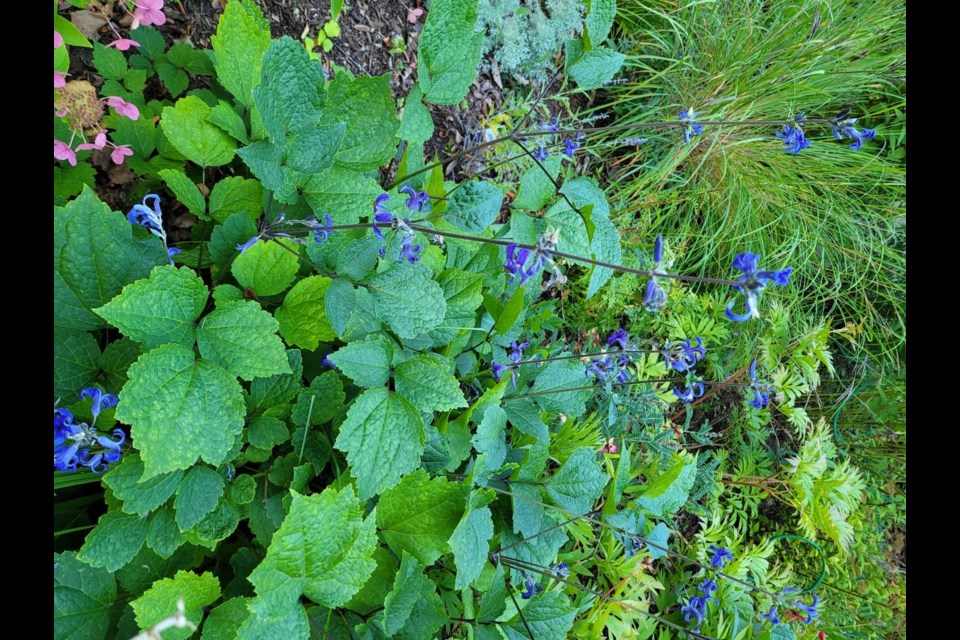Our plants provide us with much enjoyment during the gardening season, And for those of us who write about our experiences with our gardens and plants, their reach extends throughout the year.
When I was developing my front yard, I took a trip out to Langham to visit Dieter Martin’s Greenhouse. While there, I made a little side visit to Dieter Martin, the founder of this thriving family business. Dieter, although retired, continues to have a love for all plants and was eager for me to take home an ‘Alan Bloom' Clematis, to try it in my landscape.
Clematis heracleifolia 'Alan Bloom' is a clumping, shrubby clematis with lobed palmate leaves, reminiscent of cranberry leaves but more compact and rounded. A non-climber, it forms a shrub or bush with woody stems and distinct, dark green foliage which together add texture to the perennial border. In my garden it flowers in mid-September, sending up airy stalks of small, four-petaled, blue hyacinth-like flowers above the dense foliage below. After flowering it develops seed heads typical of clematis but less conspicuous. Because the flowers and seed heads don't draw your attention in the overall landscape, the plant's usefulness lies more in its stature and foliage interest. In the fall, rather than losing their leaves, they cling to the stalks, hanging down, to form a tent-like structure around the crown of the plant which catches snow and serves as protection during winter. In spring, all of the dried foliage and plant material can be removed. I usually do this after new growth has shown itself. Often you will have several shoots, away from the main plant, which can be dug up, to share with plant lovers in the neighbourhood. At most nurseries, this variety is listed as a zone 5 plant. But it has proven quite hardy in my Saskatoon yard (planted in 2018) in a not particularly sheltered location.
Like most perennials, this clematis does best in healthy, well-drained garden soil. Some say it thrives in moist conditions, but this year, with the damp spring weather, I observed that the leaves were slightly chlorotic. Since the symptoms were minor, I did not take any corrective action. Place your clematis, with its head in the sun and its feet in the shade. In other words, make sure that the base of the plant is protected by leaves or mulch in early spring. Once the plant has leafed out it will provide its own protection.
And who, may you ask, is Alan Bloom?
Alan Bloom (1906 - 2005) was a British horticulturist, the son of a market gardener. He left school at fifteen to work in different nurseries. In 1926, he returned home and helped his father transform the family business into a wholesale nursery. In 1946, he purchased Bressingham Hall and 228 acres of land and started to develop Bressingham Gardens. After a destructive gale, he briefly left the nursery and moved to Vancouver Island for two years, eventually returning. Between 1950 and 1962 he continued to develop Bressingham Nursery and gardens. The Dell Garden, 48 beds in about six acres, contains nearly 5000 different species and varieties of perennials. During his time as a nurseryman, he developed 170 new plants, many of them alpine and coniferous varieties. In 1962, he began his hobby of collecting steam engines which were finding their way to scrap heaps around the country. Soon a track was laid around the nursery and the steam engine museum was born. One of his sons now owns and operates Blooms of Bressingham. Today you can visit the Bressingham Steam Museum and Gardens, and also book into the Georgian Bressingham Hall in Norfolk for the night. During his lifetime, Alan Bloom wrote 27 books, some on steam and locomotives, one a biography, but the majority on alpine gardening and perennials.
Clematis heracleifolia 'Alan Bloom' was bred by Alan Bloom from a Manchurian and Korean variety in 1990. It was introduced as 'Alblo' in the United Kingdom by Blooms of Bressingham.
This clematis may also be available as C. 'Alblo; C. 'Bressingham Bluebird', C. heracleifolia 'Alblo', and Clematis tubulosa 'Alan Bloom'.
This column is provided courtesy of the Saskatchewan Perennial Society (SPS; [email protected]). Check out our website () or Facebook page ().




